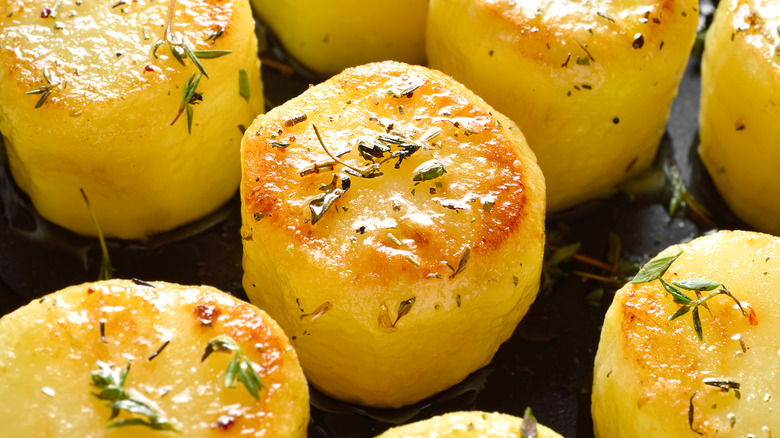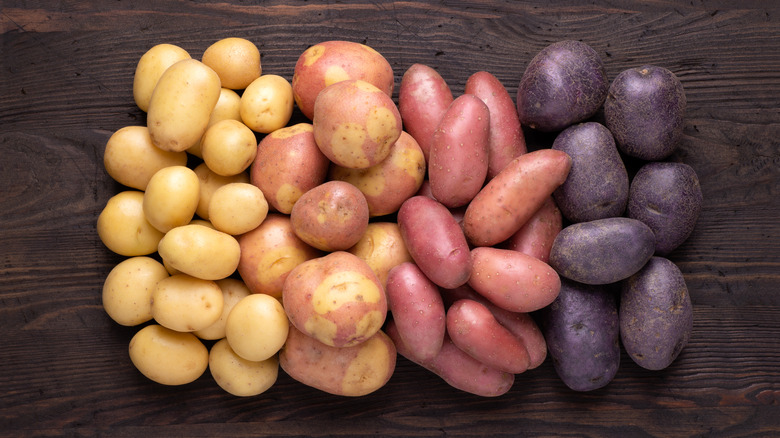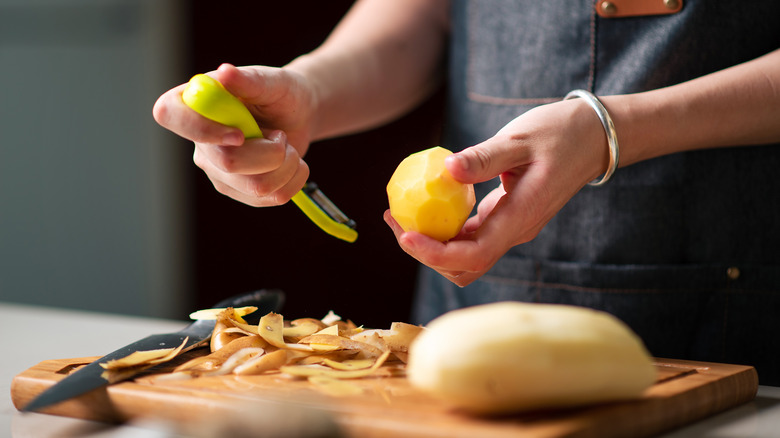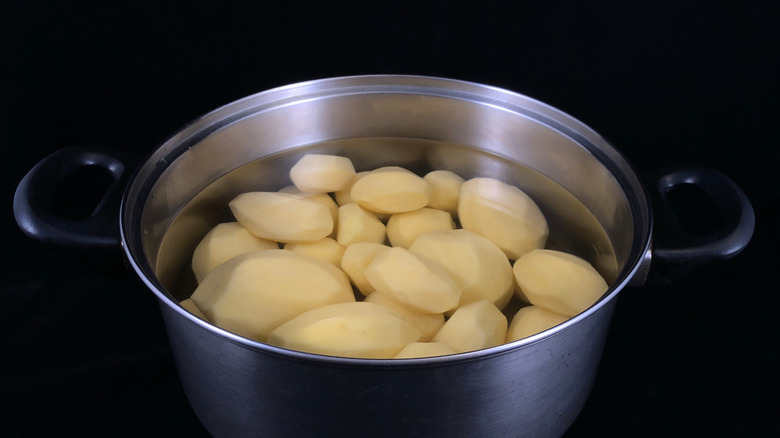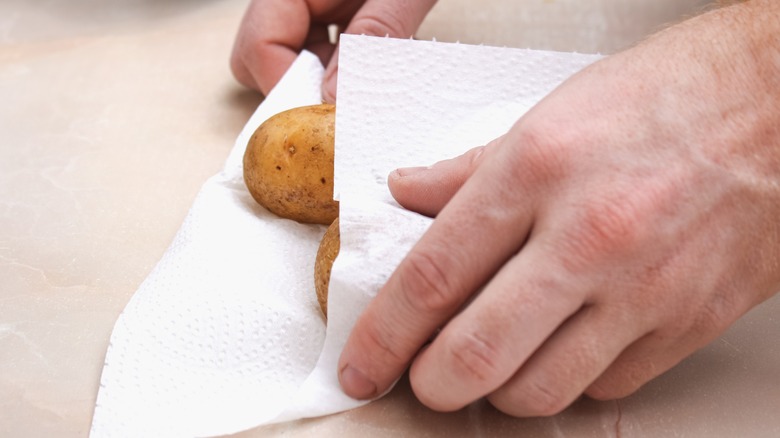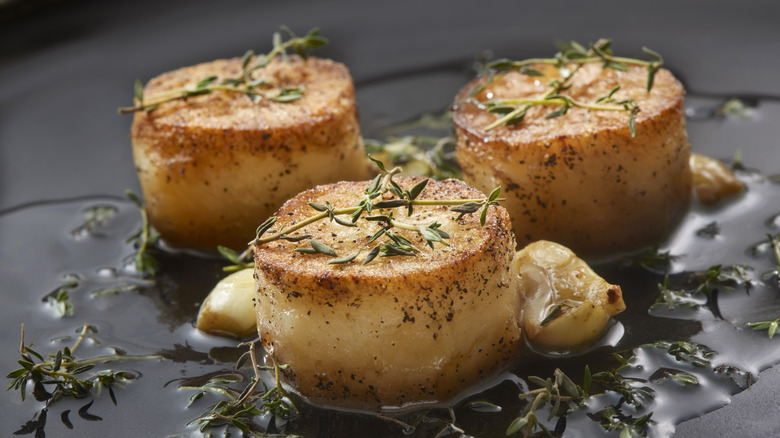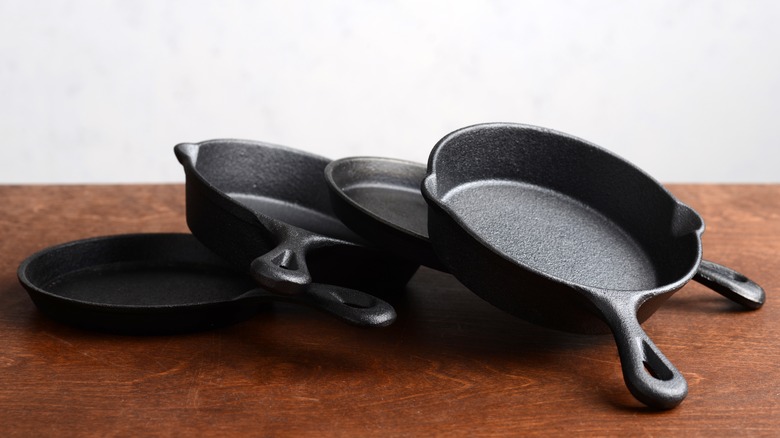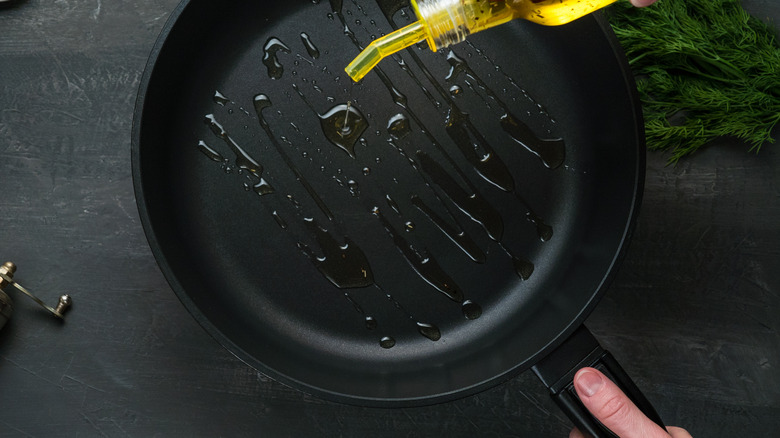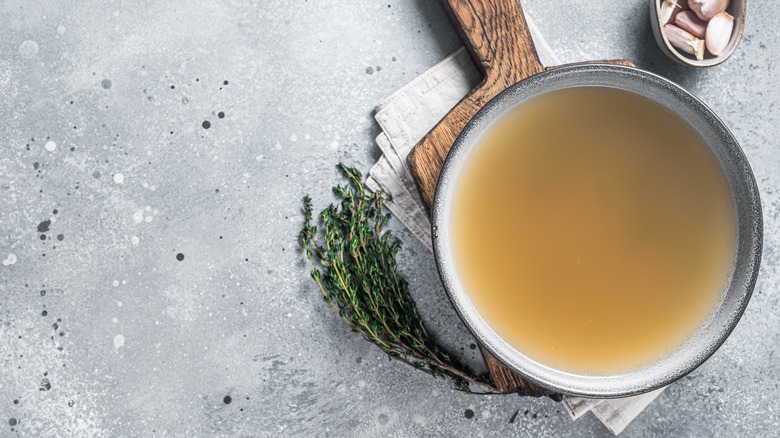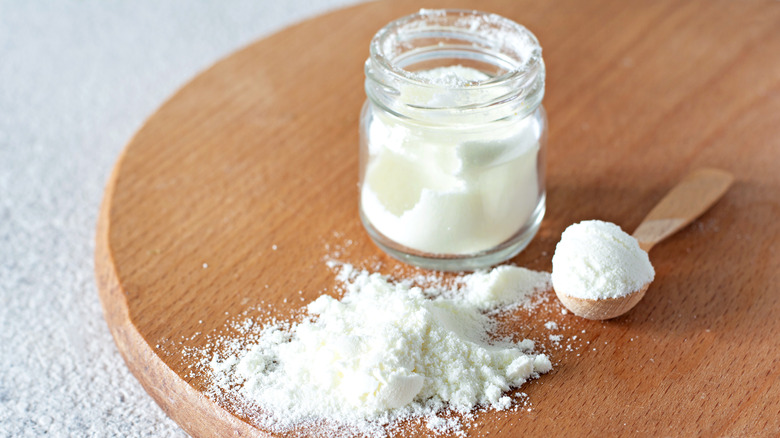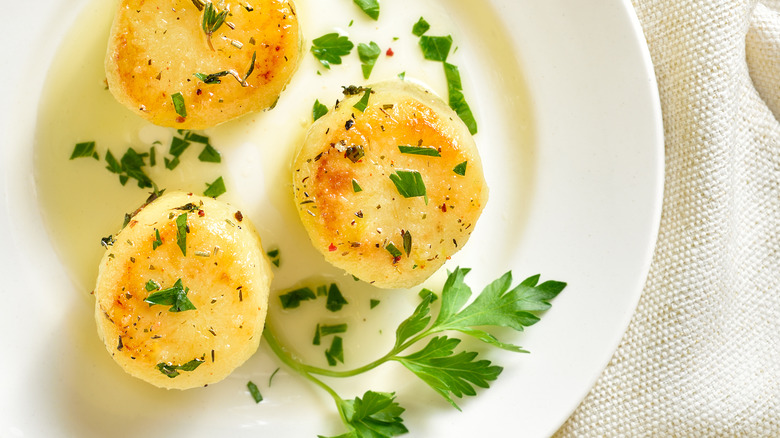11 Tips You Need To Make Perfect Fondant Potatoes
Spud fans everywhere understand that potatoes are elite, not only because of their creamy texture, accessibility, price tag, and flavor but also because of their versatility. From French fries to potato chips, mashed to scalloped potatoes ... the options are endless. Some potato dishes are rather basic and simple to make, others are considered gourmet and take hours of prep work and culinary skill to accomplish.
Fondant potatoes, also known as melt-in-your-mouth potatoes, are easily one of the most epicurean versions of the spud out there. Fondant potatoes are spuds that have been seared, fat-basted, then roasted. But because this technique is considered elite, it's important to follow all the tricks and tips you need to make perfect fondant potatoes, so you can get it right the first time.
Fondant potatoes really do dissolve upon the first bite, as their French name would suggest. The insides are like butter, while the outsides are crispy and delicious. And although the process can be quite complicated, there are some easy fondant potato recipes out there. However, it's best not to skip important steps even though some may keep you in the kitchen a little longer. In the end, it will all be worth it to take a bite into the most savory, crispy, silky, and downright delicious potato dish you've ever had the pleasure of indulging in.
Choose the right variety of potato
Those immersed in the world of potatoes know that no two potatoes are created equal. And certainly, no two varieties of potatoes taste the same. If you've grown your own, you know freshly harvested potatoes are incredibly smooth and flavorful and highly distinguishable from grocery store spuds. If you don't have the space or desire to grow your own, consider targeting locally grown potatoes from CSAs, farm stands, markets, and co-ops. It's well worth the extra effort to track down a quality, fresh potato for a recipe like fondant potatoes. Keep in mind that you'll want your potato disks to be a certain size, so your potatoes have to be at least a few inches wide. Baby potatoes and fingerlings won't be your best bet.
There are many types of potatoes out there, but two are consistently used in fondant potato recipes. Russet potatoes are the variety you typically buy when ordering a baked potato at a restaurant. They have a bright white interior and brown skin and are often large and long. They are starchy and creamy and tend to flake apart with a fork. Their skin is tougher than other varieties but edible and delicious when prepared properly. Yukon golds are yellow, smaller, sweeter, creamier, and tend to have thinner skin. Both are great options for fondant potatoes, so it all boils down to personal preference.
Use a sharp knife
Spud-based dishes come in many forms. Potatoes also vary quite a bit, so it's no wonder that fondant potatoes have a unique style. When all is said and done, fondant potatoes look quite like large scallops and cook similarly, too. They tend to be skinless and round, with a flat top and bottom, both of which will be seared to perfection. Because of this, knife work, peeling, and preparation are key. If your potato is just about the correct circumference, you can use a peeler to remove the skin from the outside. But, if it's quite a bit larger, leave it all up to a sharp knife.
If you've opted to use large potatoes, you may be able to get two or even three fondant potato disks out of each one. However, you'll want these spud rings to be uniform, so you may want to scrap the ends, and by scrap, we mean compost or cook them up in another recipe. It's important that your knife is ultra-sharp to ensure the cuts are precise and for your own safety and protection. Try testing the sharpness of your knife by cutting through veggies. If your knife slices through the potato like a breeze, then you're in the clear. Be sure your potato disks are uniform before taking the next step.
Soak your potatoes
If you've ever worked in a kitchen, you may be used to the concept of soaking potatoes. There are a lot of questions about soaking potatoes, but there are several reasons, in particular, why it works well for fondant potatoes. The main reason is that soaking peeled and cut potatoes helps to release some of the starch, which lets the potato absorb more moisture. This leads to potatoes that are silky and rich on the inside and crispy on the outside.
After peeling and cutting your potatoes, simply drop them into a bowl or bin of cold water. Leave them to soak for a minimum of 30 minutes and a maximum of 24 hours. However, if you choose to soak your potatoes for longer than 30 minutes, it's crucial that you do so in the refrigerator to avoid bacteria growth. If you don't have the refrigerator space, opt to use ice cubes to keep things cool on the countertop. Don't worry; this practice won't remove all of those good spud-tastic flavors but will instead mainly alter the texture post-cooking. You may notice that the water turns brown or even slightly red. Don't be alarmed, this is normal. You should keep that starchy water and use it to water your plants with an extra burst of nutrients.
Dry the potatoes
There are many tips you can use to get the crispiest potatoes around, but if you plan on soaking them first, one method that stands out above all else. Start by straining your potatoes from their starchy water bath. Use paper towels or clean kitchen towels to dry your potatoes. The more moisture you can absorb, the better. This will ensure the juicy goodness stays in the potato's interior and the outside dries up enough to become incredibly crispy. It also helps to wipe away any additional starch that is building on the surface. Yes, this may seem like you're over-pampering the root tuber, but rest assured that following this tip yields quite a difference in the outcome of your fondant potatoes.
For fondant potatoes, in particular, the crispy exterior and appearance are the claims to fame; it is essential to do what you can to develop the texture. Because you're not using a deep fryer like you would with French fries, more leg work must be done, including soaking and drying the spuds to get that crispy texture. However, after the spuds have been removed from the water, they will start to oxidize and turn brown. You'll want to get things cooking right along and keep them from discoloring before they hit the pan.
Season them properly
As we know, potatoes are sweet and flavorful yet very mellow and mild. This is why we often enjoy our French fries with a dipping sauce, our mashed potatoes with gravy, and our scalloped potatoes with leeks and cheese. Fondant potatoes are typically made with butter, oil, and chicken broth, but the additional seasonings are up to the chef. If you know your way around an herb garden or spice cabinet, you may have a clear idea of how to flavor your fondant potatoes. For those who prefer a recipe or to follow tips when cooking with herbs, we have a few suggestions.
Thyme is always a safe bet when paired with potatoes and French cuisine. It has a lemony, minty, and earthy flavor. You can opt to use full sprigs of fresh thyme that will crisp up right along with your potatoes or sprinkle dried thyme onto them. It's important to heat your herbs if they aren't being used as fresh garnishes to help release flavor. Rosemary is a little more intense, but another classic used in fondant potatoes. It has a similar minty flavor but with more piney-like lemon undertones. It's also quite peppery and bold, so you don't need much to make an impact. It can be added as whole fresh sprigs or dried as well. And, of course, salt and freshly cracked black pepper are the famous dynamic duo that has been adorning potatoes since they were united.
Preheat your cast iron skillet
One of Gordon Ramsay's top tips for superb fondant potatoes is to get that perfect sear on each cut side of the potato. And when it comes to fondant potato experts, he's the man we turn to. One method to achieve this is by preheating your cast iron skillet in the oven. This is why a cast iron skillet is essential when making fondant potatoes. By popping your pan in the oven, you can control exactly how hot it gets, and the even distribution of temperature is spot on. Be sure to use oven mitts when removing the pan, and place it directly onto a hot burner. A properly seasoned pan should be fairly slick, but the addition of hot fat will ensure that your potatoes will sear instead of stick.
After the fat is sizzling hot, use tongs to sear the flat side of each potato until it's crispy and golden brown. Again, think of these potatoes like scallops. You want the rim to be deep brown but also for the entire surface area to come in contact with the hot oil and crisp up. Let the potatoes sit, but to prevent burning choose a potato to check every once and a while. The concept is similar to meat that gets seared before it goes into the oven. The internal temperature is not important at this time because it will be taken care of during the next few stages.
Choose your fat wisely
Perhaps besides the potatoes themselves, the second most important ingredient for fondant potatoes is fat. This is because the crispy exterior could not be made possible without it, and in addition, the fat adds quite a bit of flavor to the recipe. As noted, potatoes themselves are rather mild in flavor, so any herbs and spices used, along with the selection of fat, are pertinent to the recipe. And there are plenty of options to choose from when it comes to selecting the type of fat to use.
Fat is used because it increases the surface temperature of food without allowing moisture to escape. This helps the interior to steam as the exterior takes the brunt of the heat and crips up rather than dries out. This is why, when it comes to fat, it's often "the more, the better."
Typically, fondant potato recipes call for butter, olive oil, or duck fat. Some call for a combination of two or all three. Olive oil has a deep floral and fruity flavor that is more botanical. Butter has a fattier mouthfeel and is creamy and sweet. Duck fat, on the other hand, is even richer, gamier, and carries a stronger flavor. It's quite complex but complements the chicken broth used in most fondant potato recipes and pairs nicely with both butter and olive oil. You can often purchase duck fat from a high-end butcher or market.
Use chicken broth
Although many potato recipes are naturally vegetarian, fondant potatoes are not. Typically, chicken broth is used shortly after the potatoes have been seared to finish them off and ensure they are buttery smooth, moist, and melt-in-your-mouth. In fact, chicken broth is often recommended for roasted potatoes and mashed potatoes because of its richness of flavor. Typically, chicken broth is made with more than just chicken and includes aromatics like onion, garlic, celery, carrots, herbs, and other vegetables that have been boiled along with the bones, skins, and other poultry parts. The notes are subtle but add layers of flavor, including saltiness. Turkey broth has a slightly gamier flavor but can make a nice alternative to chicken broth.
Once the potatoes are done crisping up in the butter, olive oil, or duck fat bath, it's time to add the broth. Add the broth or stock directly to the pan before transferring it to the oven to finish cooking. The reason broth is such an important part of the process is that it helps the interior of the potatoes to continue to steam, infuses the potatoes with flavor, and creates a famous texture that you just can't find in other potato recipes. Even if you opt to keep your skillet on the stovetop instead of transferring it to the oven, don't forgo adding the stock. If you've had a chance to make your own homemade chicken stock, even better.
Thicken your stock
A step that isn't absolutely essential but is certainly a top tip you need to make perfect fondant potatoes is to thicken your vegetable broth or stock. This can help to create a crispier surface area for your fondant potatoes, as well as allow all of those good flavors to stick to the potato with ease. Though there are endless methods you could use to go about getting that broth to the right consistency, we recommend using an unassuming pantry staple to thicken meat stock: gelatin.
Gelatin is made from animal bones and connective tissues and is often used in the production of some of our sugary favorites like gooey candies, puddings, and marshmallows (sorry, vegetarians!). It's used for its texture, not flavor, so don't worry about it modifying the profile of your fondant potatoes. In order to add gelatin to your broth, bloom it first by mixing it with cold water or broth until the powder is dissolved. Then go ahead and transfer it to your cup or pitcher of broth and give it a good mix. Gelatin is clear, so unlike some starches and flours, it won't change the overall look of your fondant potatoes, which is important for such an aesthetic dish. Gelatin thickens over time, so use less than you think you may need, and give it some time to thicken before adding your gelatin broth to the hot skillet.
Make it vegetarian or vegan
Both vegans and vegetarians rely heavily on potato dishes, especially when dining out at restaurants with few meat-free options. So, it's always a huge disappointment to discover that the only dish on the menu that appears to be veggie-friendly is, in fact, caked with duck fat or butter and infused with gelatin and chicken stock. We'd guess that the vegetarians out there are likely reading this article so as to make your own fondant potatoes at home, just how you like them. And there is certainly enough wiggle room to make them totally meat-free and even dairy-free without compromising on flavor. The outcome will have a slightly different mouthfeel and flavor profile, but the essence of crispy, creamy, melt-in-your-mouth delicious is still there.
There are a few simple swaps that need to be made. Firstly, opt to use olive oil and vegan butter instead of animal fat. If you're experimenting with vegan butter brands, give it a taste test first, both cold and melted. Next, choose a heavy vegetable broth or stock instead of a chicken-based one. Some manufacturers have even made chicken-less broths that taste quite a bit like chicken broth itself. Finally, instead of gelatin, consider an ingredient you would use to thicken a homemade soup, like corn or potato starch. Voila, vegan fondant potatoes!
Finish your dish in the oven
There's a reason that home cooks are obsessed with their cast iron pans, and will give you endless tips and tricks to keep them in pristine condition. Not only do they distribute heat like no other and are naturally non-stick when seasoned properly, but they can live on the stovetop just as comfortably as they can in the oven. This is a huge perk when it comes to making fondant potatoes because after they have finished crisping up on the stovetop and your broth has been added to the pan, it's time to pop it into the oven to finish cooking.
Even after the outside of the potatoes has reached perfection, the inside is still in need of some steaming and softening in order to reach that buttery-smooth consistency that is unique to fondant potatoes. Use an oven mitt to pop the pan back into the oven, which should be preheated. If you didn't preheat your pan in the oven before searing the potatoes, then be sure the oven is hot well before you shift your focus to heating the fat. Essentially, there should be an immediate transfer from the hot surface to a hot oven. Once the potatoes are finished and silky soft on the inside, serve them immediately. The hotter, the crispier, the better.
